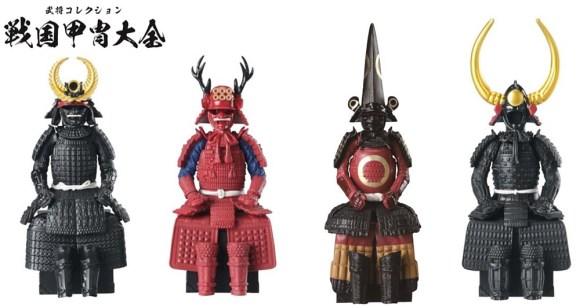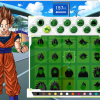
Historically accurate replicas of samurai helmets and armour will soon be coming to vending machines at castles around the country.
Capsule toy vending machines, or gachapon, are filled with all sorts of goodies. From girls wrapped up in sushi to mini folding chairs and tiny coin lockers, you never know what you might find inside one of the plastic modules.
This month, toy and hobby manufacturer Bandai will be miniaturising some of Japan’s most famous military commanders for the toy vending machine market, with a focus on striking warrior helmets and armour. There are four warriors to collect, each with a special gold version, ready to take pride of place on your desk at work or home.
Tokugawa Ieyasu (1543–1616) was a powerful and influential warrior who, in 1603, established the Tokugawa Shogunate, which would rule the country for more than 250 years following the end of the Sengoku Jidai, or Warring States Period of Japan ( c. 1467–c. 1603). The armour of the Tokugawa Family is viewed as “auspicious armour”, due to Ieyasu’s victory in the Battle of Sekigahara in 1600, so if you’re looking for good luck in studies or in business, this is the capsule toy you’re after.
Kuroda Nagamasa (1568–1623) was a prominent military commander known for his distinctive kabuto (helmet), which featured a pair of imposing water buffalo horns. The horned helmet was used as a symbol of reconciliation when Kuroda exchanged it with the helmet of the Lord of the Hiroshima Domain, Fukushima Masanori (c.1561–1624), as a testimony of their friendship after battle. The helmet was returned to the Kuroda family in 1844.
Sanada Yukimura (1567–1615) is enjoying renewed interest in Japan at the moment as the leading character in the 2016 NHK year-long TV drama Sanada Maru. As the leading general on the defending side of the Siege of Osaka, Yukimura’s legend has been retold over the centuries, with the military leader known as the “Crimson Demon of War”, due to his distinctive red armour. His helmet has hand-carved wooden antlers and six Kan’ei Tsuho, copper coins once used for currency, which are also the symbol of the Sanada clan.
Katō Kiyomasa (1561–1611) is known for building Kumamoto Castle, one of Japan’s most esteemed fortresses. Known as a ruthless fighter, Kiyomasa’s battle armour is distinctive, both in its shades of colour and its large bullseye, which is the Katō family crest. Modelled on the eboshi, traditional headdress worn by Shinto Priests, the extra tall naga eboshi helmet shown here was reserved for only top-ranking samurai.
The seven to eight-centimetre- (2.8–3.1 inch-) tall figures will be available for 400 yen (US$3.55) from 18 March at souvenir store gachapon capsule toy vending machines at: Osaka Castle, Kumamoto Castle, Himeji Castle, Hikone Castle, Nijo Castle and Ueda Castle.





 Samurai Colonel Sanders is coming to KFC stores around Japan
Samurai Colonel Sanders is coming to KFC stores around Japan Get your battle armor ready for the interactive “hottie” Samurai & Ninja Show coming to Tokyo
Get your battle armor ready for the interactive “hottie” Samurai & Ninja Show coming to Tokyo Impress your Japanese history professor with this T-shirt
Impress your Japanese history professor with this T-shirt Protect your drinks with Samurai armour bottle covers
Protect your drinks with Samurai armour bottle covers We visit the awesome new Samurai Museum in Shinjuku【Photos】
We visit the awesome new Samurai Museum in Shinjuku【Photos】 McDonald’s new Happy Meals offer up cute and practical Sanrio lifestyle goods
McDonald’s new Happy Meals offer up cute and practical Sanrio lifestyle goods All-you-can-drink Starbucks and amazing views part of Tokyo’s new 170 meter-high sky lounge
All-you-can-drink Starbucks and amazing views part of Tokyo’s new 170 meter-high sky lounge More foreign tourists than ever before in history visited Japan last month
More foreign tourists than ever before in history visited Japan last month Starbucks reopens at Shibuya Scramble Crossing with new look and design concept
Starbucks reopens at Shibuya Scramble Crossing with new look and design concept Beautiful Sailor Moon manhole cover coasters being given out for free by Tokyo tourist center
Beautiful Sailor Moon manhole cover coasters being given out for free by Tokyo tourist center Arrest proves a common Japanese saying about apologies and police
Arrest proves a common Japanese saying about apologies and police The oldest tunnel in Japan is believed to be haunted, and strange things happen when we go there
The oldest tunnel in Japan is believed to be haunted, and strange things happen when we go there Our reporter takes her 71-year-old mother to a visual kei concert for the first time
Our reporter takes her 71-year-old mother to a visual kei concert for the first time Studio Ghibli glasses cases let anime characters keep an eye on your spectacles
Studio Ghibli glasses cases let anime characters keep an eye on your spectacles Awesome website allows you to make your own Dragon Ball character, battle other fighters
Awesome website allows you to make your own Dragon Ball character, battle other fighters Disney princesses get official manga makeovers for Manga Princess Cafe opening in Tokyo
Disney princesses get official manga makeovers for Manga Princess Cafe opening in Tokyo We try out “Chan Ramen”, an underground type of ramen popular in the ramen community
We try out “Chan Ramen”, an underground type of ramen popular in the ramen community Beautiful new Final Fantasy T-shirt collection on the way from Uniqlo【Photos】
Beautiful new Final Fantasy T-shirt collection on the way from Uniqlo【Photos】 Foreign English teachers in Japan pick their favorite Japanese-language phrases【Survey】
Foreign English teachers in Japan pick their favorite Japanese-language phrases【Survey】 Is the new Shinkansen Train Desk ticket worth it?
Is the new Shinkansen Train Desk ticket worth it? There’s a park inside Japan where you can also see Japan inside the park
There’s a park inside Japan where you can also see Japan inside the park Japanese convenience store packs a whole bento into an onigiri rice ball
Japanese convenience store packs a whole bento into an onigiri rice ball Studio Ghibli releases Kiki’s Delivery Service chocolate cake pouches in Japan
Studio Ghibli releases Kiki’s Delivery Service chocolate cake pouches in Japan Japan’s bone-breaking and record-breaking roller coaster is permanently shutting down
Japan’s bone-breaking and record-breaking roller coaster is permanently shutting down New definition of “Japanese whiskey” goes into effect to prevent fakes from fooling overseas buyers
New definition of “Japanese whiskey” goes into effect to prevent fakes from fooling overseas buyers Foreign passenger shoves conductor on one of the last full runs for Japan’s Thunderbird train
Foreign passenger shoves conductor on one of the last full runs for Japan’s Thunderbird train Our Japanese reporter visits Costco in the U.S., finds super American and very Japanese things
Our Japanese reporter visits Costco in the U.S., finds super American and very Japanese things Kyoto bans tourists from geisha alleys in Gion, with fines for those who don’t follow rules
Kyoto bans tourists from geisha alleys in Gion, with fines for those who don’t follow rules Studio Ghibli unveils Mother’s Day gift set that captures the love in My Neighbour Totoro
Studio Ghibli unveils Mother’s Day gift set that captures the love in My Neighbour Totoro Domino’s Japan now sells…pizza ears?
Domino’s Japan now sells…pizza ears? New Japanese KitKat flavour stars Sanrio characters, including Hello Kitty
New Japanese KitKat flavour stars Sanrio characters, including Hello Kitty Sales of Japan’s most convenient train ticket/shopping payment cards suspended indefinitely
Sales of Japan’s most convenient train ticket/shopping payment cards suspended indefinitely Sold-out Studio Ghibli desktop humidifiers are back so Totoro can help you through the dry season
Sold-out Studio Ghibli desktop humidifiers are back so Totoro can help you through the dry season Japanese government to make first change to romanization spelling rules since the 1950s
Japanese government to make first change to romanization spelling rules since the 1950s Ghibli founders Toshio Suzuki and Hayao Miyazaki contribute to Japanese whisky Totoro label design
Ghibli founders Toshio Suzuki and Hayao Miyazaki contribute to Japanese whisky Totoro label design Doraemon found buried at sea as scene from 1993 anime becomes real life【Photos】
Doraemon found buried at sea as scene from 1993 anime becomes real life【Photos】 Tokyo’s most famous Starbucks is closed
Tokyo’s most famous Starbucks is closed One Piece characters’ nationalities revealed, but fans have mixed opinions
One Piece characters’ nationalities revealed, but fans have mixed opinions We asked a Uniqlo employee what four things we should buy and their suggestions didn’t disappoint
We asked a Uniqlo employee what four things we should buy and their suggestions didn’t disappoint Princesses, fruits, and blacksmiths: Study reveals the 30 most unusual family names in Japan
Princesses, fruits, and blacksmiths: Study reveals the 30 most unusual family names in Japan Studio Ghibli’s new desktop Howl’s Moving Castle will take your stationery on an adventure
Studio Ghibli’s new desktop Howl’s Moving Castle will take your stationery on an adventure We build miniature Japanese samurai warrior armour out of metal
We build miniature Japanese samurai warrior armour out of metal Look out! Here comes the Samurai Spider-Man
Look out! Here comes the Samurai Spider-Man Kamon kamon kamon kamon…branding? Pumps to bring out your inner feudal warlord
Kamon kamon kamon kamon…branding? Pumps to bring out your inner feudal warlord Katana coasters! Samurai sword tableware brings bushido to your home
Katana coasters! Samurai sword tableware brings bushido to your home We check out the new Samurai Star Wars figurines from Bandai and Tamashii Nations【Pics】
We check out the new Samurai Star Wars figurines from Bandai and Tamashii Nations【Pics】 New series gives Tomica toy cars a Feudal makeover with samurai-inspired designs
New series gives Tomica toy cars a Feudal makeover with samurai-inspired designs Did samurai use armoured cats and mice in battle?
Did samurai use armoured cats and mice in battle? Need a new job? Japanese tourism organization is looking to hire two samurai
Need a new job? Japanese tourism organization is looking to hire two samurai Shogun sweets? Trees said to be planted by first Tokugawa shogun still bear fruit used for sweets
Shogun sweets? Trees said to be planted by first Tokugawa shogun still bear fruit used for sweets Awesome Samurai Armor Hoodies are looking to conquer the whole world/keep you warm
Awesome Samurai Armor Hoodies are looking to conquer the whole world/keep you warm Capsule toy machines in Japan have taken to selling face masks too
Capsule toy machines in Japan have taken to selling face masks too Sailor Moon girls appear as samurai and ninja in five-piece character art collection
Sailor Moon girls appear as samurai and ninja in five-piece character art collection Sorry, ladies: Yokohama’s got all-new “Japan”-themed capsule hotel rooms just for men
Sorry, ladies: Yokohama’s got all-new “Japan”-themed capsule hotel rooms just for men New Japanese gacha capsule vending machine toys bring you sheep’s clothing to dress your cats in
New Japanese gacha capsule vending machine toys bring you sheep’s clothing to dress your cats in “Get them drunk then chop off their heads.” Samurai’s assassination plot against U.S. envoys found
“Get them drunk then chop off their heads.” Samurai’s assassination plot against U.S. envoys found Mutant parrot-banana hybrids appearing across Japan 【Photos】
Mutant parrot-banana hybrids appearing across Japan 【Photos】
Leave a Reply